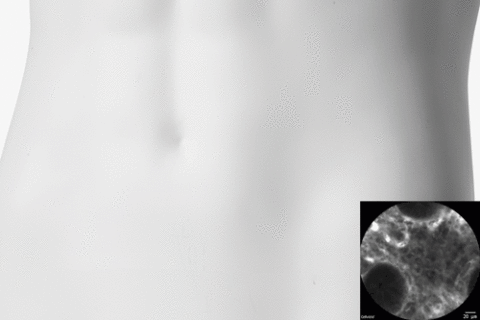Endomicroscopy: Rapid test for polyps
In Germany, approximately 400,000 people suffer from chronic bowel disease such as Crohn’s disease or ulcerative colitis. A dysfunction of the intestinal barrier is often at least partly responsible for the disease developing. The intestinal barrier transfers nutrients from the intestines into the bloodstream, but usually also acts as a protective barrier against pathogens. If it ceases to work properly, it can cause stomach ache and bloody diarrhoea. The quality of life decreases as the risk of developing cancer increases.
Treatment can relieve symptoms, but the disease cannot be cured. Patients are subjected to a long, protracted process of finding the right medicines to treat their condition. Standard endoscopy is often not suitable for determining whether the chosen medicines are actually helping, as the resolution is too low. Endomicroscopy, however, allows even tiny tissue structures of only one thousandth of a millimetre in size to be viewed clearly. ‘Endomicroscopy can be used in addition to a normal endoscopy to check patients more thoroughly,’ explains Dr. Timo Rath, Professor for Molecular Endoscopy. ‘The extra examination requires a contrast agent and is over in a matter of minutes.’
The technique uses confocal laser microscopes which are pushed through the flexible shaft for instruments in a standard endoscope. Deep in the intestines, light at a frequency of 488 nanometres is shone onto the mucous membranes and operators then measure which wavelengths are reflected. The microscope is designed specially to ensure that scattered light does not give a false reading. This method allows doctors to detect even the smallest of holes in the intestinal wall.
Being able to detect holes reliably is a crucial factor when judging whether treatment should be continued or not. ‘90 percent of patients who have an intact barrier once treatment has ended are still free from symptoms one year later,’ says Rath. ‘In the case of those who do not have an intact barrier by this time, only 20 to 30 percent are free from symptoms.’ According to Rath, a study of 170 patients showed that endomicroscopy was a valuable resource for specialists when deciding how to proceed in any particular case. The final results will soon be published.
Another option which helps specialists decide on the best treatment for growths on the intestinal wall (polyps) is chromoendoscopy. There are two types of polyps: those which are harmless and those which could develop into cancer at some point. There is no need to worry about the first type, but pre-cancerous polyps could mutate into a cancerous tumour over time. The problem from the point of view of the specialist making a diagnosis is that until now it was not possible to accurately differentiate between both types just by inspecting them in the intestine using an endoscope. There was therefore no choice but to subject the patient to an endoscopic resection of every polyp found. ‘It is crucial that adenomas are removed reliably and entirely, whilst hyperplasia are benign and can remain in the intestine,’ says Rath.
Rath hopes that virtual chromoendoscopy will drastically cut the number of unnecessary operations. Using optical light filters, shining light of different wavelengths into the intestines and subsequently examining the results via digital processing allows benign and malignant polyps to be differentiated accurately. Experts also call the process an optical biopsy.
In order to categorise the different types of polyps, Rath and his team first examined a large number of polyp patients using chromoendoscopy and then compared their results with those obtained after histological analysis by pathologists. ‘At present, we can predict which type a polyp is with more than 90 percent accuracy,’ explains Rath. Their aim, however, is to reach a success rate exceeding 99 percent, in order to reduce the risk for patients to virtually zero: ‘We are using methods from artificial intelligence and are currently training our computers with thousands of images.’
He believes the effort is worthwhile, not only from a medical but also from an economic point of view. After all, approximately half of all adults have polyps. ‘There are estimates in the US,’ says Rath, ‘that using this method could lead to cost savings of approximately one billion US dollars per year currently incurred for treating polyp patients.’
by Frank Grünberg
Here we present four further imaging methods:
Computer tomography: weight-bearing scans
Light-sheet microscopy: an underground train system for immune cells
Endomicroscopy: diagnosing tissue without artificial contrast agents
Multi-spectral optoacoustic tomography (MSOT): tracking haemoglobin
FAU research magazine friedrich
 This article first appeared in our research magazine friedrich. You can order the print issue (only available in German) free of charge at presse@fau.de.
This article first appeared in our research magazine friedrich. You can order the print issue (only available in German) free of charge at presse@fau.de.
